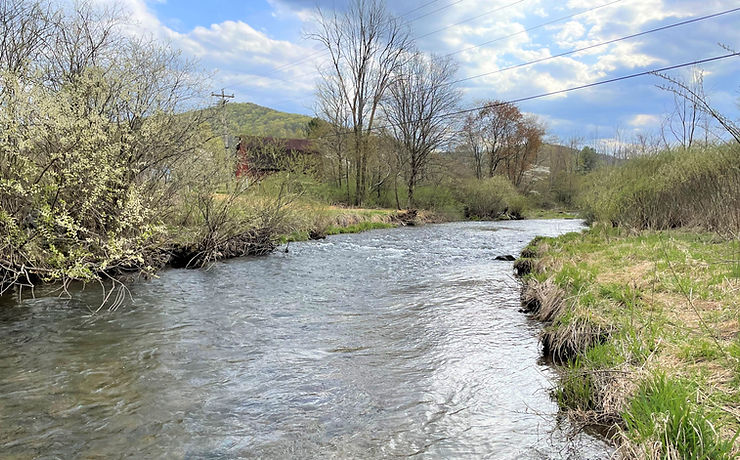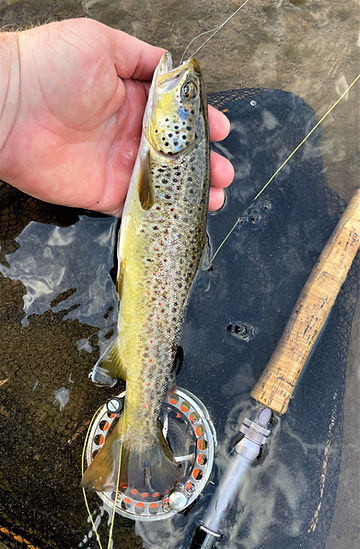The Other Pine Creek: Fly Fishing West Branch Pine Creek

West Branch Pine Creek is a 17-mile tributary of Big Pine Creek in Potter County. The stream begins just east of Cherry Springs State Park, and West Branch Road closely follows the stream from its headwaters clear to where it joins with Pine to form Berger Lake in Galeton.
The past year or so, I’ve driven past this stream numerous times on my way to other destinations. I’m not really sure why except that, when you live in an area of exceptional trout streams, sometimes even the simply good ones get overlooked. And West Branch Pine Creek definitely falls into that category: it’s a good trout stream.
Wild and Stocked
West Branch Pine Creek is a high gradient stream with lots of riffles and pocket water. It’s a smaller stream, ranging 20-30 feet wide in the lower five or six miles and half that size above where Lyman Run enters.
Above Lyman Run, West Branch Pine Creek is a Class A wild trout fishery with a mix of browns and brook trout. It offers 7 miles of skinny, brush-choked water that’s a challenge to fish once the foliage starts to fill out, which is really when it starts getting good.
Beavers have done a good job of restructuring the whole stream throughout a big stretch of the Class A water. How this will impact West Branch long term remains to be seen, and many streams in this region are experiencing the same shift. The headwaters of East Fork Sinnemahoning Creek, Little Kettle Creek, and the Allegheny River are also under siege by these oversized rodents, and I can’t tell yet whether this will provide lasting value or result in ruined waters should the beavers ever leave.
Upstream from the beaver ponds along West Branch Road, the stream becomes more fly fisher friendly. The mature forest provides a heavy canopy that keeps the stream cold and there’s not so much brushy undergrowth to contend with. It is small water, but there are fish throughout, and anywhere you find holding water, you’ll find trout.

West Branch Pine Creek downstream from its confluence with Lyman Run is primarily a stocked fishery. The PA Fish & Boat Commission stocks rainbows and browns here a couple times per year. The water generally warms up too much during the summer months for trout to hold over, although there are some very deep pools throughout where I’m sure they do.
I’d love to see what West Branch Pine Creek could be if not for the influence of Lyman Run. Lyman Run Lake is a top-release dam that has degraded the lower half of Lyman Run and, consequently, West Branch Pine Creek. If ever the DCNR decided to rethink many of the little reservoirs across this state so that they were bottom-release dams, we’d see a drastic improvement in literally hundreds of waterways across the state. In this water system alone, two lakes (Lyman Run and Berger Lake in Galeton) negatively impact Big Pine Creek. Imagine if these dams were redesigned to be bottom-release, feeding their respective streams with cold water all summer long?
It’s a pipe dream, I know, but imagine!
There has been talk floating around Potter County of turning West Branch Pine Creek into a whitewater destination for kayakers. Although it’s a small stream, its steep gradient offers some potential in this area. The only thing it lacks is volume. If they could find a way to create consistent flows year round, it’s certainly a possibility. As interest grows in outdoor recreation in northcentral Pennsylvania, I am ruling nothing out. There’s a deep desire among some very influential people here to further develop the resources in Potter and Tioga counties (in good and bad ways, in my opinion, but that’s a topic for another story) to increase year round attractions for tourists. As it is, the amount of traffic from non-anglers and non-hunters has boomed throughout this region in recent years. It would be nice if it resulted in something positive for outdoorsmen, but unfortunately that’s not usually the case.

(Photo: A downstream view from the bridge in Germania Station. As far as scenery goes, West Branch Pine Creek is absolutely beautiful.)
Fly Hatches
West Branch Pine Creek has some fly hatches and some of them are heavy. I’ve fished this stream several times this spring and have witnessed bugs in the air every time. Blue Quills, Quill Gordons, Grannoms, Hendricksons, March Browns, Sulphurs, Green Drakes, Slate Drakes and others are found here.
West Branch Pine Creek is the type of stream where you’ll rarely find a pool with 20 trout rising to a hatch. This is primarily pocket water and riffles and the trout are spread throughout the stream. When I’ve observed bugs in the air, I’ve done well just blind fishing a dry fly to match whatever hatch is coming off. In fast water, trout tend to be more opportunistic because they don’t have time to study your pattern. This is also perfect water for dry/dropper presentations. Drop a small nymph on 6-8 inches of tippet from the bend of the dry fly hook and you’ll pick up fish on both patterns.
There are a few freakishly large pools along West Branch, though, downstream from Lyman Run. They’re typically the result of huge rock formations that create a quick drop in elevation, or what you could consider a waterfall effect — except that they’re more like miniature waterfalls. The result is random huge pools that seem out of place on an otherwise small stream.

Stream Access
The lower sections of West Branch Pine Creek flow through a few commercial and residential areas. Most of these landowners permit walk-in only access to the stream as long as you’re mindful of where you park.
West Branch Road parallels the stream its entire length. As you head up the valley, you’ll see numerous turnouts where you can park to access the stream. There are a few short sections posted no trespassing, but most of the stream is open to fishing.
In a region known for some great trout streams, West Branch Pine Creek often gets overlooked. But if you’re looking to explore some new water with great potential for both stocked and wild fish, West Branch Pine Creek is definitely worth a visit.
Did You Enjoy What You Just Read?
Stay up to date with the Dark Skies Fly Fishing monthly newsletter for free and receive the latest posts in fly fishing news, tricks, tips, and techniques, stream reports, as well as updates on new flies added to the Online Store and exclusive discounts!
Sign Up Now
North Central Pennsylvania is dotted with small flood control and recreation reservoirs that later became state parks. To name a few are George B. Stevenson, Alvin R. Bush, Lyman Run Lake and Parker Dam. Please do not mistaken, many of my fondest memories from the time I was a kid through adulthood is camping and spending days swimming, fishing, playing wiffle ball and chasing frogs at Sinnamahoning, Kettle Creek and parker Dam State Parks. My entire family and friends, often numbering twenty or more people, would take day trips to these destinations from our cabin in Grant, PA. These SPs are lovely spots for families and children nestled in remote, rugged and beautiful country to relax and find joy.
However, as an experienced fly fisherman in his mid forties that now fishes these watersheds regularly, I also speculate what the tailwater fisheries might be like if fed by bottom release dams. When many of these dams were originally constructed in the 1950s, the purpose was for controlling floods that destroyed or damaged property, towns and villages downstream. This is honorable. Why did the Army Corps of Engineers erect them as top release? Is this a more practical design for flood control? Or, is this design simpler to build and/or more cost effective?
Finally, I can only deduce that transitioning these existing top releases to bottom releases would be quite the project and cost many millions of tax payer dollars. This would be a project that I would welcome my state tax contributions be spent on. But, I cannot imagine that bottom release dams in under populated regions for the purpose of improving trout fishing ranks highly on the list of ways to spend public money for most Pennsylvanians.
As a matter of fact, I am guessing that the vast majority of Pennsylvanians cannot pronounce Sinnamahoning or have even heard of Potter and Cameron Counties. I, personally, want to keep it this way.
Nonetheless, a man can dream of bottom releases that create a year round cold water fishery in his neck of the woods.
Justin
Thanks for your comment, Justin! Sounds like you’ve made a lot of great memories at these parks over the years. That’s awesome.
I’m not sure why they were built as top release/overflow dams. I’m guessing a combination of cheaper and easier, especially considering many were built by CCC‘s as a way of putting Americans back to work and pulling the country out of the Great Depression. So these designs perhaps gave the government more “bang for their buck,” so to speak?
I’m in the same category as you…I’ve driven along it a number of times and never fished it. Historically beavers were very important to the West Branch. I remember reading or maybe an old conservation officer (Ken Able) told me of catching many large brook trout behind the beaver dams, this would have been probably post WWII time frame. There is so much potential, if only to repurpose the damns or god forbid create some new bottom flow damns in some strategic places. I used to day dream about ways to make FF, Kettle, and Pine enhanced year round fishing destinations.
Jim and I will be staying across the street from FF lodge. Jim will be there from this Sat through Wed. Look forward to hopefully seeing you then.